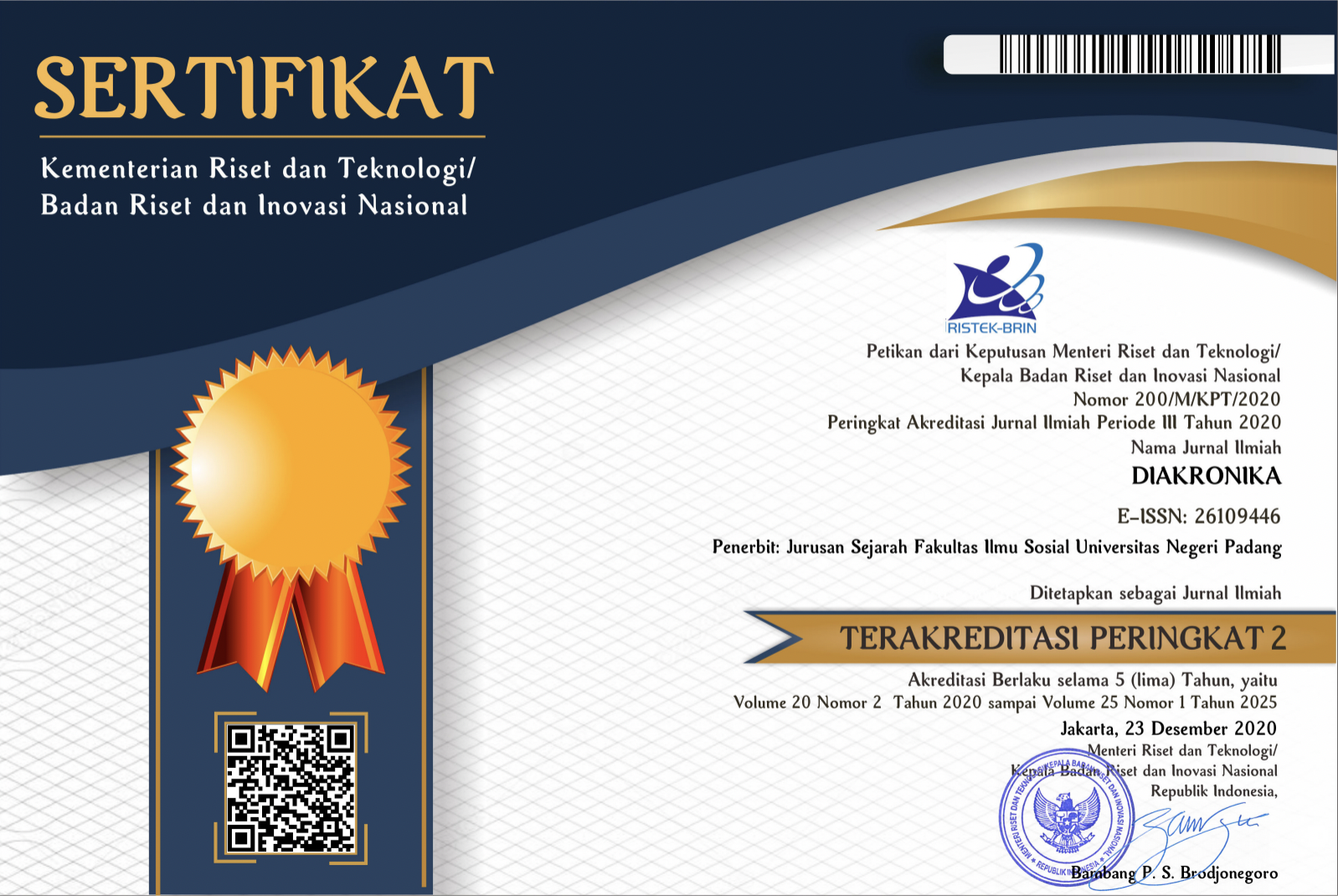Revitalizing Character Values in the Folklore of the Arjuna Mountain Slope Site
Abstract
Mount Arjuna is not only a popular tourist destination in Indonesia because of its outstanding natural beauty. Mount Arjuna also has a cultural heritage reflected in its sites. The slopes of Mount Arjuna have diverse folklore. Revitalization of folklore values on the slopes of Mount Arjuna is an essential step in maintaining cultural heritage and preserving local identity. The objectives of this study are 1) to study the folklore on the slopes of Mount Arjuna and 2) to design a revitalization of the folkloric values of the Lereng Gunung Arjuna site. This research uses a historical method consisting of four stages, namely heuristics, criticism, interpretation, and historiography, with an empirical approach. Data analysis was done comparatively by proving the Lereng Gunung Arjuna site and the Lereng Gunung Arjuna folklore. The results showed 1) there are 19 folklors contained in each site. Sites of Mount Arjuna Slope, namely Oento Boego Cave, Watu Kursi, Eyang Madrim, Rahtawu or Tampuono, Eyang Sekutrem, Eyang Abiyoso, Nogo Gini Cave, Sendang Dewi Kunti, Puthuk Lesung, Eyang Sakri, Eyang Semar, Dwarapala Statue, Makuthoromo, Sendang Widodari, Wejangan Cave, Rancang Kencono, Candi Wesi, Sendang Drajat, Sepilar; 2) Local wisdom as a concept of preserving the environment wrapped in harmony between the value of divinity-humanity-nature around. The existing local wisdom is used as an inspiration for the mechanism of social life. The implementation of revitalization requires support from the parties (multi-stakeholders), and then the folklore is preserved and adjusted by the social context and changing times. Various existing folklore has the potential to be transformed elsewhere. In education, it is introduced and converted to school students so that local wisdom as an ancestral heritage and potential can be changed as a guide for the next generation's life.
Downloads
References
Amanat, T. (2019). CERITA RAKYAT PASER DAN BERAU DALAM TINJAUAN EKOLOGI SASTRA (The Paser’s and Berau’s Folklores in Ecocriticism Review). Kandai, 15(2), 145. https://doi.org/10.26499/jk.v15i2.956
Aristama, M. F., Andalas, E. F., & Sugiarti, S. (2020). Dampak dan Fungsi Mite Semar Bagi Kehidupan Masyarakat Lereng Gunung Arjuna. Poetika, 8(1), 1. https://doi.org/10.22146/poetika.v8i1.55300
Charles R. Ngangi. (2011). Konstruksi Sosial dalam Realitas Sosial Charles R. Ngangi. Agri-Sosioekonomi, 7(2), 1–4. https://doi.org/10.35791/agrsosek.7.2.2011.85
Dafirah, D., Pammuda, P., & Teng, B. A. (2022). Procession of Making Holy Water for the Addinginging-Dinging Rituals in the Tenro Communities of Selayar Islands. Proceedings of the 9th Asbam International Conference (Archeology, History, & Culture Like Malay) (ASBAM 2021), 660(Asbam 2021), 600–604. https://doi.org/10.2991/assehr.k.220408.083
Dzulkifli, M., Rohman, A. Z. F., Damayanti, R., & Samsudin, A. (2023). Analisis Pengembangan Pariwisata Pendukung Kawasan Arjuno Agrotechnopark Kabupaten Pasuruan. Jurnal Ilmiah Pariwisata, 2(2), 57–69.
Indrahti, S. (2012). Kudus dan Islam: Nilai-Nilai Budaya Lokal dan Industri Wisata Ziarah. Madina. http://eprints.undip.ac.id/39024/2/buku_KUDUS_DAN_ISLAM.pdf
Juliani Sukmana, W. (2021). Metode Penelitian Sejarah. Seri Publikasi Pembelajaran, Vol 1 No 2(April). https://www.researchgate.net/publication/351097486_METODE_PENELITIAN_SEJARAH
Junaini, E., Agustina, E., & Amril Canrhas. (2017). Analisis Nilai Pendidikan Karakterdalam Cerita Rakyat Seluma. Jurnal Korpus, 1(1), 39–43. https://doi.org/10.33369/jik.v1i1.3202
Karima, E. M., & Abianza, E. (2023). Pendidikan karakter melalui kisah tokoh sejarah lokal dalam kurikulum merdeka. 58–65. https://doi.org/10.51190/jazirah.v4i1.101
Karyanta, N. A., Suryanto, S., & Hendriani, W. (2020). Menggunakan metode historis komparatif dalam penelitian psikologi. Jurnal Psikologi Sosial, 18(2), 145–156. https://doi.org/10.7454/jps.2020.15
Kasmin, Y. (2017). Arkeologi Pemukiman Situs Pongka, Kabupaten Bone, Sulawesi Selatan. Jurnal Walennae, 15(1), 43. https://doi.org/10.24832/wln.v15i1.3
Kristiana, Y. (2019). Buku Ajar Studi Ekowisata. Deepublish. https://books.google.co.id/books?hl=id&lr=&id=MYS5DwAAQBAJ&oi=fnd&pg=PR5&dq=ekowisata&ots=aedZ_69kaX&sig=Iem4JJ1106gEEVpgXLgJyyNjnfo&redir_esc=y#v=onepage&q=ekowisata&f=false
Lestari, R. N. S., & Subadyo, A. T. (2017). Revitalisasi Situs Patirtan Watugede Singosari sebagai Obyek Wisata Spiritual Berkelanjutan. 2013, B171–B176. https://doi.org/10.32315/sem.1.b171
Mardiana, H., Yonata, H., Attamanoo, H., & Napudin, A. (2021). Basic Ethics of Religious Leaders as Social Adhesives in Society. Religious: Jurnal Studi Agama-Agama Dan Lintas Budaya, 5(2), 149–160. https://doi.org/10.15575/rjsalb.v5i2.10691
Margaretha, R. (2017). Analisis Klasifikasi Mitos dalam Tradisi Lisan Masyarakat Lampung. Jurnal Pendidikan Progresif, 7(2), 117–126. https://doi.org/10.23960/jpp.v7.i2.201715
Marsudi, M. (2015). Bangkitnya Tradisi Neo-Megalitik di Gunung Arjuna. . . Sejarah Dan Budaya: Jurnal Sejarah, Budaya, Dan Pengajarannya, 9(1), 79–87.
Novitasari, S., & Anggraini, P. (2021). Simbol Tokoh Pewayangan pada Novel Hati Suhita Karya Khilma Anis. In Prosiding Seminar Nasional Bahasa Dan Sastra Indonesia (SENASBASA, 5(1).
Nurgiyantoro, B. (2011). Wayang Dan Pengembangan Karakter Bangsa. Jurnal Pendidikan Karakter, 1(1), 18–34. https://doi.org/10.21831/jpk.v1i1.1314
Phan, H. T., & Van Le, H. (2022). Stories of the Trees: Understanding Traditions and Transitions in the Katu Peoples’ Perceptions of Forests in Central Vietnam. In Sacred Forests of Asia. Routledge. https://doi.org/10.4324/9781003143680-20
Priatna, Y. (2017). Melek Informasi Sebagai Kunci Keberhasilan Pelestarian Budaya Lokal [Information Literacy is the Key to Success in Preserving Local Culture]. Publication Library and Information Science, 1(2), 37–43. https://doi.org/10.24269/pls.v1i2.720
Prilosadoso, B. H., Atmaja, N. R. A. C. D., & Murwanti, S. (2021). Revitalization of Folklore and Actualization Efforts Through Visualization Animation Media in Early Childhood Character Building. International Journal of Social Sciences and Humanities Available Online at Www.Sciencescholar.Us, 5(1), 1–8. https://doi.org/10.29332/ijssh.v5n1.590
Raharjo, R. P., & A.S., A. K. (2021). Values Associated With Humans As Social Beings in Myth Dewi Kilisuci. Jurnal DISASTRI: Pendidikan Bahasa Dan Sastra Indonesia, 3(3), 223–232.
Rawanda, R., Winarno, G. D., Febryano, I. G., & Harianto, S. P. (2020). Peran Folklore Dalam Mendukung Pelestarian Lingkungan Di Pulau Pisang. Journal of Tropical Marine Science, 3(2), 74–82. https://doi.org/10.33019/jour.trop.mar.sci.v3i2.1915
Sari, I. A. . (2022). Cerita Rakyat Bali Aga dan Ainu Jepang. Lembaga Studi Sosial dan Agama.
Setianingsih, A. T., Drakel, J. K. A., Octavina, M. T., & Wisnu. (2022). Eksistensi Penghayat Kepercayaan Kejawen Di Tengah Arus Modernisasi Agnes. The Indonesian Journal of Social Studies, 6(2), 79–86. https://journal.unesa.ac.id/index.php/jpips/article/view/8508/4156
Setiawan, E. (2017). Makna Filosofi Wayang Purwa Dalam Lakon Dewa Ruci. Kontemplasi: Jurnal Ilmu-Ilmu Ushuluddin, 5(2). https://doi.org/10.21274/kontem.2017.5.2.399-418
Singh, R. P. B., Niglio, O., Ities, I. N. H. I. C., Eritage, C. U. E. H., Singh, R. P. B., & Niglio, O. (2022). Historic Cities & Cultural-Religious Heritage: Preservation & Regeneration. Esempi Di Architettura, 2.
Sinthumule, N. I. (2022). Gender and sacred natural sites: The role of women in sacred sites protection and management in Vhembe region, Limpopo Province of South Africa. Global Ecology and Conservation, 35. https://doi.org/10.1016/j.gecco.2022.e02099
Siswanto, N. (2019). Filosofi Kepemimpinan Semar. Panggung, 29(3). https://doi.org/10.26742/panggung.v29i3.1011
Sukmawan, S. (2018). Sastra Lingkungan: Sastra Lisan Jawa dalam Perspektif Ekokritik Sastra. Universitas Brawijaya Press.
Surpi, N. K., Avalokitesvari, N. N. A. N., Untara, I. M. G. S., & Sudarsana, I. K. (2021). Interpretation of Symbols, Veneration and Divine Attributes in Dieng Temple Complex, Central Java. Space and Culture, India, 8(4), 60–77. https://doi.org/10.20896/saci.v8i4.991
Swastika, K. (2020). Kebudayaan Megalitik Di Daratan Tinggi Iyag-Ijen Jejak-Jejak, Kronologi, serta Gambaran Sistem Budaya dan Sistem Sosial Pendukungnya. LaksBang PRESSindo.
Titisari, E. Y., Antariksa, Wulandari, L. D., & Surjono. (2018). Sumber Air Dalam Ruang Budaya Masyarakat Desa Toyomerto Singasari,Malang. Space, 5(1), 77–90. https://doi.org/10.24843/JRS.2018.v05.i01.p08
Zarkasi, F. (2021). TASAWUF AND MILLENNIAL YOUTH (In the Perspective Suluk Linglung Sunan Kalijaga). KASTA : Jurnal Ilmu Sosial, Agama, Budaya Dan Terapan, 1(1), 92–104. https://doi.org/10.58218/kasta.v1i1.76





